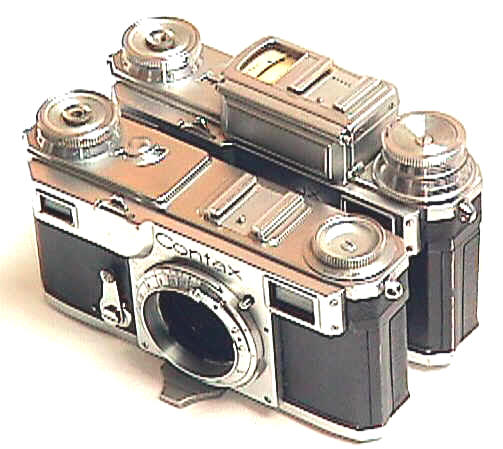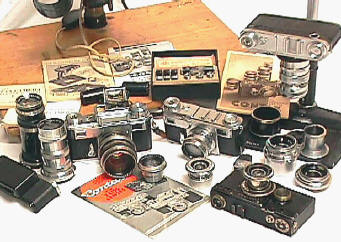- As well a being more expensive than the Leica the Contax was much bigger, heavier and far less easy to use. At 78.5.0 with the f1.5 Sonnar it was an extremely expensive camera. The 324 filters with this example are for the f1.5 Sonnar and f2.8 Biogon, they differ from other 42 mm push-on filters in having a much thinner mount.
- An interesting detail on Contax/Pentacon cameras: There were two serial numbers, one on the outside lower back, and another on the inside, seen vertically when opening the back door. The first one says 44 626. As I compared this sample to others, placing it into the early series production, I had a hard time understanding this relatively high.
- Zeiss Contax IIa and IIIa. Postwar Precision 1950-61. The Zeiss Contax was arguably the best 35mm rangefinder made before WWII, with a larger range of faster and sharper lenses than Leica. Many considered the pre-war Contax the 'professional' 35mm camera, while the Leica was for amateurs.
(a)CZJ = Carl Zeiss Jena (pre war)
Contax IIIA - serial number C 4924 Lens Carl Zeiss Tessar 1:3.5/50 mm no. 1004229 - rare (it usually was fitted with a 1:5/50 mm) Excellent condition: amazingly preserved by an enthusiast. Complete with original Contax leather case, with strap. The Carl Zeiss Tessar is clean, without residues or scratches, it opens smoothly. Freehand 8.0 software, free download. In March 1936, the Contax II camera designed by Hubert Nerwin was.
Itdoes seem that very low numbers do exist, and it is suggested that they beginat Jena at 1,000 in about 1890, unless information to the contrary is found.
Theremay also be unnumbered lenses, possibly when they are one of a stereo pair,though confusion with licencees lenses can occur.
Twolistings then exist, and run very much in parallel. One is by G. Gilbert, in'Collecting Photographica' and is reproduced in the back of McKeown's 'Price Guide'. The other is given in 'ChiffresCles' by P-H. Pont.
Asa collector, the main point is that they do tell the same story within the timespan that interests one.
Thefollowing is a shortened version of the one in 'Chiffres Clef' withsome extra notes added from experience here. It is tentative in places.

1890 Anastigmat production begins. this is partlylicensed to others, including Voigtlaender for Germany. The earliest ZeissAnastigmat noted so far is No 1,51x suggesting a possible No 1,000 start atJena for camera lenses: but note an aplanat for projection seems anomalous.
1895 Voigtlaender stops production of Zeiss designs,suggesting Zeiss had expanded production facilities to make the lenses at Jena.
1900 c. 44,040 as Unar sales begin, production ofanastigmats reaches 100,000, with about 44,000 by Zeiss and 56,000 underlicense.
1902 Tessar f 6.3 launched. This must have been onefactor leading to a big expansion of demand and production.
1908 91,711 + 103,3xx, 104,2xx noted on camerasburgled at N&G, London (Manthos article), but note N&G may have laggedin fitting as cameras made in 1912 had lenses No 133,73x- say a year in storeor transit.
Year Serial Number (begin + end) numbersused
1912 173,418 - 200,520 27,102
1913 208,473 - 249,350 40,877 Carl Zeiss London here (see below)
1915 c282,800 - c284,500 1,700
1917 289,087 - 298,157 9,070
1919 322,799 - 351,611 28,812
1921 433,273 - 438,361 5,088
1923 561,270 - 578,297 17,027
1925 c631,500 - c648,500 29,513
1927 722,196 - 798,251 76,055
See Full List On Camerapedia.fandom.com
1929 919,794 - 1,016,885 97,091
1931 1,239,699 - 1,365,582 125,883 First Contax lenses here.

1933 1,436,671 - 1,456,003 19,332
1935 1,615,764 - 1,752,303 136,539
1936 1,674,882 - 1,942,806 267,924 chrome finish begins at c1,89 million.
1938 2,267,991 - 2,527,984 259,993
1940 2,652,000 - c2,678,000 26,000
1942 2,800,000 - ?
Notethe variation in the number per year. Now a plant of a successful company doesnot vary that much in production rate unless there is diversion to otherproducts, as is likely during a war (binoculars?, gunsights?) numbered inanother series. Or there is a cessation of materials or labour, which can alsohappen in war. These will have affected things in say 1916 to 1918 but it doesseem likely that the numbers used in 1913 are a 'funny' and one feelsthey include some for 1914 as well.
Contax Iii Serial Numbers Diagram
Alsonote that there are gaps between the 'Years lens' numbers, as for No252,739 in 1914 end and No 282,800 for 1915 begin, where 30,061 numbers are'missing.'
Thetables admit that the WW1 data is approximate and this might explain the lowfigure apparent for 1914. It seems likely that there was a carry over ofnumbers in some years from one year to the next, due to numbers being bookedfor a contract or sale in advance- or some such mechanism.
Thereis a instinctive feeling that in 1912, the plant was actually normally makingabout 25,000-30,000 lenses. Now going backwards, it is likely that productionhad built up slowly as labour was trained and plant designed and built, andthat a typical serial number for 1900 might be No 40,000 (as suggested above),rather than No 75,000 which would be the mid-point from No 1000 to say No151,000 in 1910.
AfterWW1, there is a rapid recovery of production, but again there are bigfluctuations in the apparent yearly numbers produced.
Thereare also still gaps between the blocks of numbers attributed to years. It doesseem that production was set to rise steadily in the 1920's, even though therewas a recession, and especially after the formation of Zeiss Ikon with therelated rationalizations and a 'captive' market.
Thusby 1930, there do seem to be some 100,000 or more per year, and then in the1930's, up to 250,000 or 300,000 numbers per year used. This suggests a majorexpansion at Jena, or just possible the use of the redundant plants ofGoerz/Berlin and Ernemann/Dresden to support the production in some way.
Allthis does also raise one point: that any maker quickly finds that while brassand glass cost money, numbers are 'free' and makers often'waste' numbers when plans change or products are cancelled. Thus itis normal to find cases where lenses were never made to match numbers reservedfor them.
Oneis left with a feeling that early Zeiss lenses are rare and should be verydesired items. An authentic list Carl Zeiss supplied to a friend in 1967, withthe same general result, was as follows:
150,000 - 200,000 1912 ca.
300,000 - 350,000 1916-1919
500,000 - 750,000 1923-1926
1,000,000 - 1,500,000 1929-1934
2,000,000 - 2,800,000 1937-1942
AfterWW2, Carl Zeiss at Oberkochen began a new series of numbers, probably at No1,000 or 10,000 and as indicated above, these were normally also marked Optonand coated. The Opton mark lasted for most purposes until about 1953 at No1,100,000 but was used for many more years for items sold in the Comeconcountries- which will cause confusion if it is not realized. More data thanthis is in P-H Pont's 'Chiffres Cles'.
POST WAR
(b)CZJ = Carl Zeiss Jena Postwar (DDR-East Germany)
2,842,301 primo Tessar 5cmf/3,5 CZJ DDR (si distinguono dalla scritta “Germany”)
1945-1949 3,00 - 3,20 million Initiallywith the focal length in centimeters.
1952-1955 3,47 - 4,00 million From here focal lengths were given in millimeters.
1958-1961 5,00 - 6,00 million
1964-1967 7,00 - 8,00 million
1970-1975 9,00 - 10,0 million
(c)CZ = Zeiss-Opton / Carl Zeiss, Oberkochen (RFT - West Germany)
1946-195110,000-500,000 These will be engraved Zeiss Opton,
1949la prima ottica Zeiss-Option per Contax è un Sonnar 135/4 sn 91,001 del 1949,ma si tratta di un lotto isolato fabbricato a Coburgo
1951parte la produzione regolare per Contax con un Sonnar 50/1,5 sn 47,000 del1951, con sn dunque inferiore rispetto a quello di due anni prima!
questodimostra come la numerazione sia indipendente dalla cronologia
1953-1953 1,100,000 - 1,256,000
1953-1959 1,256,001 - 2,600,000 Now just Carl Zeiss (**) except for Comecon sales


1961-1965 3,000,000 - 4,000,000
1969-1971 5,000,000 - 6,000,000
(*)i primi Zeiss Opton avevano una T rossa (che io conosca con SN più alto con Trossa è 887,xxx)
(**)Ufficialmente il cambio di nome si ebbe al sn 1,256,000
CarlZeiss con SN 1,167,xxx
CarlZeiss con SN 820,412
Inumeri di matricola dei singoli obiettivi possono servire come riferimento per identificarel’anno di produzione, ma in realtà questo metodo non è sempre esatto. Alcuniobiettivi sono stati fabbricati all’interno di lotti fuori dalle normalisequenze produttive, per cui non sempre la sequenza numerica risulta rispettatacorrettamente.
Unesempio lampante è dato da alcuni lotti d’obiettivi Sonnar 13,5 cm, inizianticol numero di matricola 1,500,000, sequenza che normalmente si riferisce al1934, ma che in realtà è stata assegnata ad obiettivi prodotti nel 1936 edoltre. In casi come questo è probabile che gli obiettivi in questioneappartenessero a serie speciali, forniture particolari, o fossero esemplari dipre-produzione.
Altroesempio di confusione numerica si è verificato verso la metà degli anni Trenta,quando la produzione degli obiettivi neri e nichelati si è sovrapposta allanuova serie d’ottiche cromate. In ogni caso è accertato che esistono lottilasciati momentaneamente liberi ma poi assegnati successivamente.Dell’Orthometar 3,5 cm mancano, ad esempio, le date di consegna per ambedue ilotti costruttivi.
Durantela guerra, tra il 1940 e il 1945, la situazione si fa sempre più confusa: inumeri di matricola si accavallano senza apparente logica.
Adesempio, vi sono lotti del 1944 posizionati come numerazione all’interno del1940, e numerosi lotti del 1941 che possiedono numeri di matricola superiori ailotti del 1945.
Gliobiettivi con numerazione intorno a 2,600,000 in apparenza prodotti negli anni1944/45, appartengono quasi sempre a lotti del 1940, e in generale la numerazionetra 2,600,000 e 2,700,000 è quasi sempre inaffidabile per identificare l’esattoanno di produzione.
Lasituazione si stabilizza solo nei primi mesi del 1946, quando la normalesequenza numerica viene ristabilita.
Ancheper quello che riguarda i registri di Oberkochen si assiste a contraddizioninella numerazione.
Citiamoad esempio un Sonnar 50mm f/2, con sn 824,840 ed un Sonnar 50 mm f/1,5 con sn820,412 marcati ‘Carl Zeiss’, che teoricamente dovrebbero essere marcati 'Zeiss–Opton”, poiché i Sonnar siglati Carl Zeiss sono iniziati ufficialmentesolo col numero 1,256,001.
